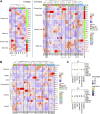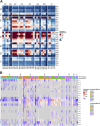Exploring the tumor micro-environment in primary and metastatic tumors of different ovarian cancer histotypes
- PMID: 38328306
- PMCID: PMC10847324
- DOI: 10.3389/fcell.2023.1297219
Exploring the tumor micro-environment in primary and metastatic tumors of different ovarian cancer histotypes
Abstract
Ovarian cancer is a highly heterogeneous disease consisting of at least five different histological subtypes with varying clinical features, cells of origin, molecular composition, risk factors, and treatments. While most single-cell studies have focused on High grade serous ovarian cancer, a comprehensive landscape of the constituent cell types and their interactions within the tumor microenvironment are yet to be established in the different ovarian cancer histotypes. Further characterization of tumor progression, metastasis, and various histotypes are also needed to connect molecular signatures to pathological grading for personalized diagnosis and tailored treatment. In this study, we leveraged high-resolution single-cell RNA sequencing technology to elucidate the cellular compositions on 21 solid tumor samples collected from 12 patients with six ovarian cancer histotypes and both primary (ovaries) and metastatic (omentum, rectum) sites. The diverse collection allowed us to deconstruct the histotypes and tumor site-specific expression patterns of cells in the tumor, and identify key marker genes and ligand-receptor pairs that are active in the ovarian tumor microenvironment. Our findings can be used in improving precision disease stratification and optimizing treatment options.
Keywords: cancer associated fibroblasts; cell type annotation; ligand-receptor analysis; metastatic tumor site; ovarian cancer histotypes; primary tumor site; single-cell tumor profiling; tumor micro-environment.
Copyright © 2024 Xie, Olalekan, Back, Ashitey, Eckart and Basu.
Conflict of interest statement
The authors declare that the research was conducted in the absence of any commercial or financial relationships that could be construed as a potential conflict of interest.
Figures




Similar articles
-
Integrative genomics approach identifies molecular features associated with early-stage ovarian carcinoma histotypes.Sci Rep. 2020 May 14;10(1):7946. doi: 10.1038/s41598-020-64794-8. Sci Rep. 2020. PMID: 32409713 Free PMC article.
-
Genomic and TCR profiling data reveal the distinct molecular traits in epithelial ovarian cancer histotypes.Oncogene. 2022 May;41(22):3093-3103. doi: 10.1038/s41388-022-02277-y. Epub 2022 Apr 25. Oncogene. 2022. PMID: 35468938
-
High-grade serous tubo-ovarian cancer refined with single-cell RNA sequencing: specific cell subtypes influence survival and determine molecular subtype classification.Genome Med. 2021 Jul 9;13(1):111. doi: 10.1186/s13073-021-00922-x. Genome Med. 2021. PMID: 34238352 Free PMC article.
-
The Evolution of Ovarian Carcinoma Subclassification.Cancers (Basel). 2022 Jan 14;14(2):416. doi: 10.3390/cancers14020416. Cancers (Basel). 2022. PMID: 35053578 Free PMC article. Review.
-
Three-Dimensional Modelling of Ovarian Cancer: From Cell Lines to Organoids for Discovery and Personalized Medicine.Front Bioeng Biotechnol. 2022 Feb 10;10:836984. doi: 10.3389/fbioe.2022.836984. eCollection 2022. Front Bioeng Biotechnol. 2022. PMID: 35223797 Free PMC article. Review.
Cited by
-
Identification biomarkers and therapeutic targets of disulfidptosis-related in rheumatoid arthritis via bioinformatics, molecular dynamics simulation, and experimental validation.Sci Rep. 2025 Mar 13;15(1):8779. doi: 10.1038/s41598-025-93656-4. Sci Rep. 2025. PMID: 40082645 Free PMC article.
-
Stemness-driven clusters in ovarian cancer: immune characteristics and prognostic implications.Front Oncol. 2025 Jun 11;15:1577283. doi: 10.3389/fonc.2025.1577283. eCollection 2025. Front Oncol. 2025. PMID: 40567611 Free PMC article.
-
Applications and techniques of single-cell RNA sequencing across diverse species.Brief Bioinform. 2025 Jul 2;26(4):bbaf354. doi: 10.1093/bib/bbaf354. Brief Bioinform. 2025. PMID: 40698863 Free PMC article. Review.
References
LinkOut - more resources
Full Text Sources
Molecular Biology Databases

